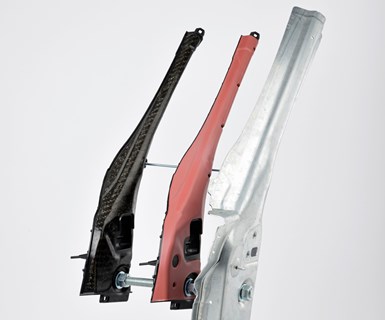Composite insert as a structural reinforcement for A-pillars
A Porsche structural A-pillar reduces weight and increases strength with a hybrid part combining thermoplastic composites, steel and structural foam.

The 3D hybrid A-pillar extends upward from the vehicle rocker panel, accommodates the door hinges and holds the windshield in place at the side. Source | LANXESS AG
The Porsche (Stuttgart, Germany) 911 Cabriolet that rolled out this year is the first vehicle manufactured with a lightweight, hybrid metal-composite A-pillar designed for use in convertibles and roadsters.
The hybrid metal-composite pillar contains an insert made from high-strength steel, supported on the inside by a formed blank of polyamide 6-based LANXESS (Pittsburgh, Pa., U.S.) Tepex dynalite 102-RG600(6)/47% continuous fiber-reinforced thermoplastic composite, and by a ribbed structure made from polyamide 66-based, short glass fiber-filled Durethan AKV30H2.0. This structure is bonded by friction with L-5235 structural foam developed by L&L Products (Romeo, Mich., U.S.). LANXESS says its Tepex line of thermoplastic composite materials is particularly suited for structural components in passenger cars, with their stringent safety requirements.
The strength and rigidity of the hybrid insert ensures that the A-pillar is just as good at withstanding rollovers as previous designs featuring high-strength steel tubes. However, it is 5 kilograms lighter. The weight reduction is achieved in the “greenhouse” area of the vehicle, lowering the car’s center of gravity and thereby improving vehicle dynamics.
“The excellent mechanical performance of the hybrid A-pillar demonstrates that hybrid inserts based on steel sheet, Tepex blanks, polyamide 6 or polyamide 66 variations of Durethan as a back-injection material and on a structural foam such as L-5235 also offer considerable potential for use in structural lightweight vehicle body design. That applies to electric vehicles in particular, as their heavy batteries give them a high impact mass,” explains Henrik Plaggenborg, head of Tepex Automotive at the LANXESS High Performance Materials (HPM) business unit. “The weight reduction also extends the range of the electric vehicles that use this technology.”
Other potential applications for the hybrid composite elements include reinforcing crossmembers and side members, B- and C-pillars, load-bearing battery parts or door components that are critical to safety.
The hybrid composite elements were developed and are manufactured by L&L Products at its site in Strasbourg, France. The first step in the manufacture of the reinforcing elements involves forming and overmolding the Tepex blanks in a single operation using the hybrid molding technology. The resultant composite component is then coated with an epoxy-based foam bonding system that expands in response to heat. The coated part is mounted on the body and goes through the cathodic dip coating (KTL) process with it. The high temperatures of the KTL process cause the structural foam to expand and bond with the high-strength sheet steel, which is also affixed to the A-pillar casing, to produce the reinforcing hybrid insert. This last step takes place in an entirely automated manufacturing process that was developed by Porsche and is subject to ongoing quality control.
The insert and A-pillar development process was supported by LANXESS’ HiAnt customer service operation. “Services included simulating the forming (draping) of the Tepex blanks, simulating filling for back-injection and calculating warpage. We also determined material characteristics to simulate the mechanical behavior of the A-pillar and made these figures available to Porsche,” says Jean-Marie Olivé, expert in application development at HPM.
Related Content
TU Munich develops cuboidal conformable tanks using carbon fiber composites for increased hydrogen storage
Flat tank enabling standard platform for BEV and FCEV uses thermoplastic and thermoset composites, overwrapped skeleton design in pursuit of 25% more H2 storage.
Read MoreMFFD thermoplastic floor beams — OOA consolidation for next-gen TPC aerostructures
GKN Fokker and Mikrosam develop AFP for the Multifunctional Fuselage Demonstrator’s floor beams and OOA consolidation of 6-meter spars for TPC rudders, elevators and tails.
Read MoreDeveloping repairs for thermoplastic composite aerostructures
HyPatchRepair project proves feasibility of automated process chain for welded thermoplastic composite patch repairs.
Read MoreJeep all-composite roof receivers achieve steel performance at low mass
Ultrashort carbon fiber/PPA replaces steel on rooftop brackets to hold Jeep soft tops, hardtops.
Read MoreRead Next
VIDEO: High-volume processing for fiberglass components
Cannon Ergos, a company specializing in high-ton presses and equipment for composites fabrication and plastics processing, displayed automotive and industrial components at CAMX 2024.
Read MoreDeveloping bonded composite repair for ships, offshore units
Bureau Veritas and industry partners issue guidelines and pave the way for certification via StrengthBond Offshore project.
Read MorePlant tour: Daher Shap’in TechCenter and composites production plant, Saint-Aignan-de-Grandlieu, France
Co-located R&D and production advance OOA thermosets, thermoplastics, welding, recycling and digital technologies for faster processing and certification of lighter, more sustainable composites.
Read More
.jpg;width=70;height=70;mode=crop)





















